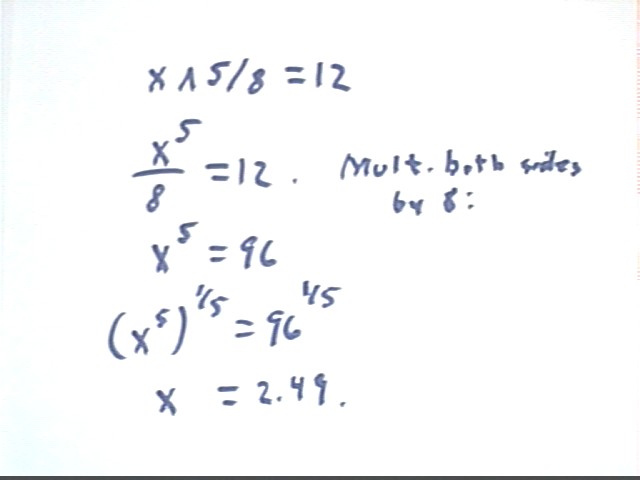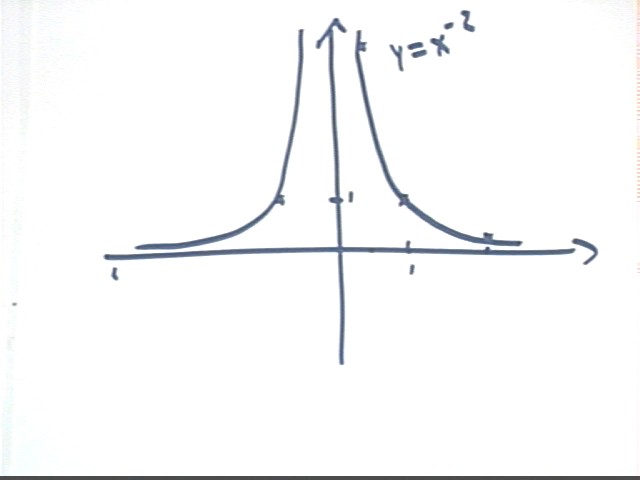
Precalculus I Class 02/20
Quickly plot:
y = x^-2
We mentally calculate y at x = 1/2, 1 and 2, obtaining values 4, 1 and 1/4. Plotting these basic points and recalling how the vertical and horizontal asymptotes are formed we get the first-quadrant part of the graph as shown below.
We then note that negative values of x will give the same results as the corresponding positive values, making the graph symmetric with respect to the y axis. This allows us to sketch the second-quadrant part of the graph as a 'reflection' of the first-quadrant part.

y = x^3
We mentally calculate y at x = 1/2, 1 and 2, obtaining values 1/8, 1 and 8. Plotting these basic points and recalling how the vertical and horizontal asymptotes are formed we get the first-quadrant part of the graph as shown below.
We then note that negative values of x will give the same results. except negative, as the corresponding positive values, making the graph symmetric with respect to the y axis. This allows us to sketch the second-quadrant part of the graph as a 'reflection' of the first-quadrant part.
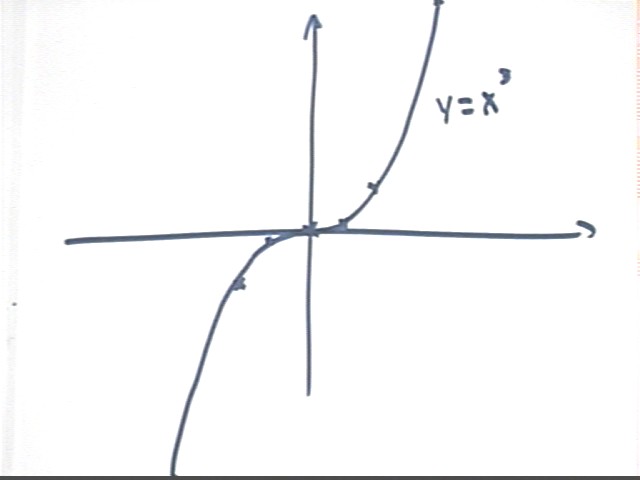
y = x^4
We mentally calculate y at x = 1/2, 1 and 2, obtaining values 1/16, 1 and 16. Plotting these basic points and recalling how the vertical and horizontal asymptotes are formed we get the first-quadrant part of the graph as shown below. We note that compared to a parabola the values of y = x^4 stay closer to the x axis when x < 0, especially when x is near 0, and that the graph goes up much more quickly when x > 1.
We then note that negative values of x will give the same results as the corresponding positive values, making the graph symmetric with respect to the y axis. This allows us to sketch the second-quadrant part of the graph as a 'reflection' of the first-quadrant part.
Note that steps in the construction of the graph of y = .1 (x+3)^4 - 1, a problem given below, are also indicated on this graph. The explanation will be given with that problem.
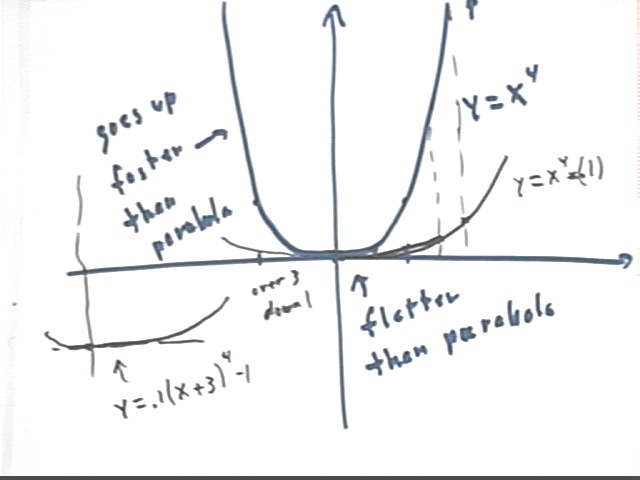
y = x^-1
We mentally calculate y at x = 1/2, 1 and 2, obtaining values 2, 1 and 1/2. Plotting these basic points and recalling how the vertical and horizontal asymptotes are formed we get the first-quadrant part of the graph as shown below.
We then note that negative values of x will give the same results as the corresponding positive values, making the graph symmetric with respect to the y axis. This allows us to sketch the second-quadrant part of the graph as a 'reflection' of the first-quadrant part.
Note that steps in the construction of the graph of y = 4 x^-1, part of a problem given below, are also indicated on this graph. The explanation will be given with that problem.
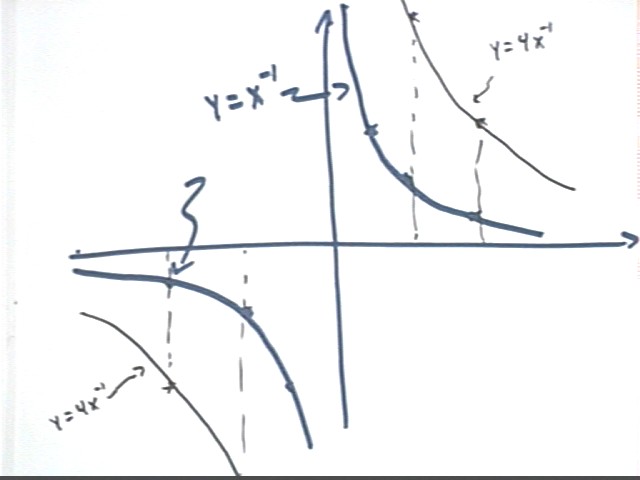
y = (x-2)^-3 + 2
We construct the y = x^-3 graph as a basis for the desired graph.
The graph of y = (x-2)^-3 + 2 is shifted 2 units to the right and 2 units up. The easiest way to construct the resulting graph is to sketch x and y axes both shifted 2 units in the positive direction, then to shift the graph of y = x^-3 so that the resulting graph will have asymptotes at the 'new' set of axes.
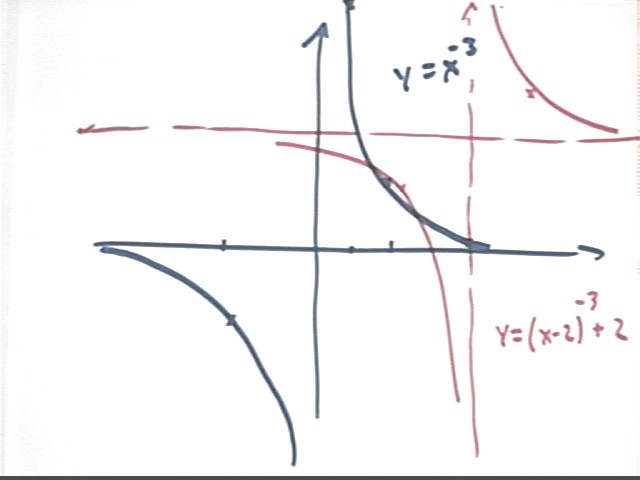
y = .1 (x+3)^4 - 1
Refer to the graph of y = x^4, sketched above.
We first vertically stretch that graph by factor .1, which moves each point 10 times closer to the x axis to give us the graph of 6 = .1 x^4.
We then shift the new graph -3 units in the horizontal direction and -1 units in the vertical direction. This moves its 'vertex' from (0, 0) to (-3, -1), where we sketch a 'new' set of axes to assist in sketching the translated graph.
These graphs are shown more accurately in the figure below:
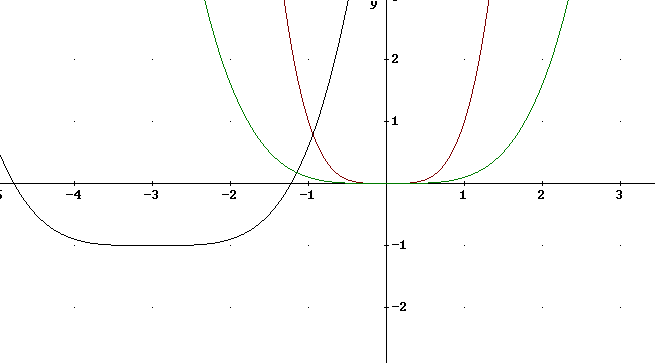
y = 4 * x^-1 + 3
Refer to the graph of y = x^-1, sketched above.
We first vertically stretch that graph by factor 4, which moves each point 4 times further from the x axis to give us the graph of y = 4 x^-1.
We will then shift the new graph 3 units in the vertical direction. This moves its 'vertex' from (0, 0) to (0, 3), where we will sketch a 'new' set of axes to assist in sketching the translated graph. This is not shown on the graph above.
The corresponding graphs are all shown accurately in the figure below:
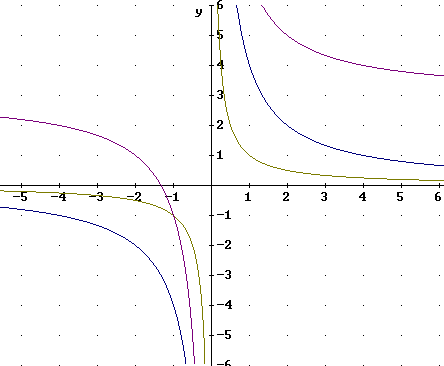
Suppose that a(n) = a(n-1) + 3, a(1) = 9.
Find a(2), a(3), a(4), a(5) and a(3598).
To get a(2): Plug in 2 for n to get
Simplify to get
Substitute the known value of a(1) to get
Simplify to get
To get a(3): Start with a(n) = a(n-1) + 3 and plug in 3 for n to get
Simplify to get
Substitute the known value of a(2) to get
Simplify to get
To get a(4): Start with a(n) = a(n-1) + 3 and plug in 4 for n to get
Simplify to get
Substitute the known value of a(3) to get
Simplify to get
At this point we see that a(n) will go up by 3 every time n goes up by 1, so we have the sequence
a(1), a(2), a(3), a(4), a(5), ... =
9, 12, 15, 18, 21, ...
So what is that term a(3598)?
Starting at a(1) we have to make 3598 - 1 = 3597 'jumps' each of 3 units.
The total 'jump' is therefore 3 * 3597 = 10791.
You started at 9 so you end up at 9 + 10791 = 10800.
So a(3598) = 10800.
Now try the relation a(n) = a(n-1) + 3 n, a(1) = 9. Get the first few numbers, then try to predict a(3597).
We get sequence a(1), a(2), a(3), a(4), a(5), ... equal to
9 15 24 36 51 ...
The details are shown below, where we have used subscripts (e.g., a with subscript n) instead of function notation a(n):
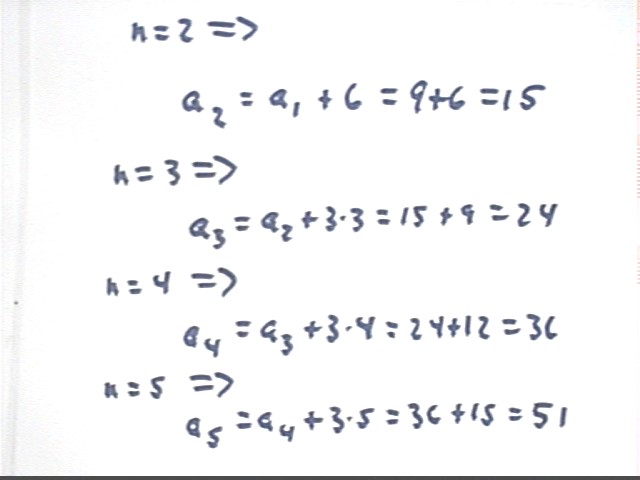
Analysis of differences tell us that this sequence is quadratic.

So a(n) is a quadratic function of n. It follows that a(n) is of form y = a n^2 + b n + c, the the a in 'a(n)' refers to the function a and the a in front of n^2 refers to the constant a in the form of a quadratic function.
We can substitute any three 'data points' to get a, b and c.
Using the first three (n, a(n)) points (1,9), (2,15) and (3,24) we get equations:
These equations can be solved using the techniques developed in the first few classes. Solutions are a = 1.5, b = 1.5 and c = 6.
So a(n) = 1.5 n^2 + 1.5 n + 6.
We got the function so how do we find a(3597)?
Plug in n = 3597. We get
a(3597) = 19,413,015
There's another way to get this result, using simple arithmetic and common sense. See if you can figure it out.
Note that x^5/8 = 12 means (x^5) / 8 = 12, since exponentiation precedes division.
If we wanted the exponent to be 5/8 we would have to write this x^(5/8) = 12.
We solve this equation as indicated in the figure below.
